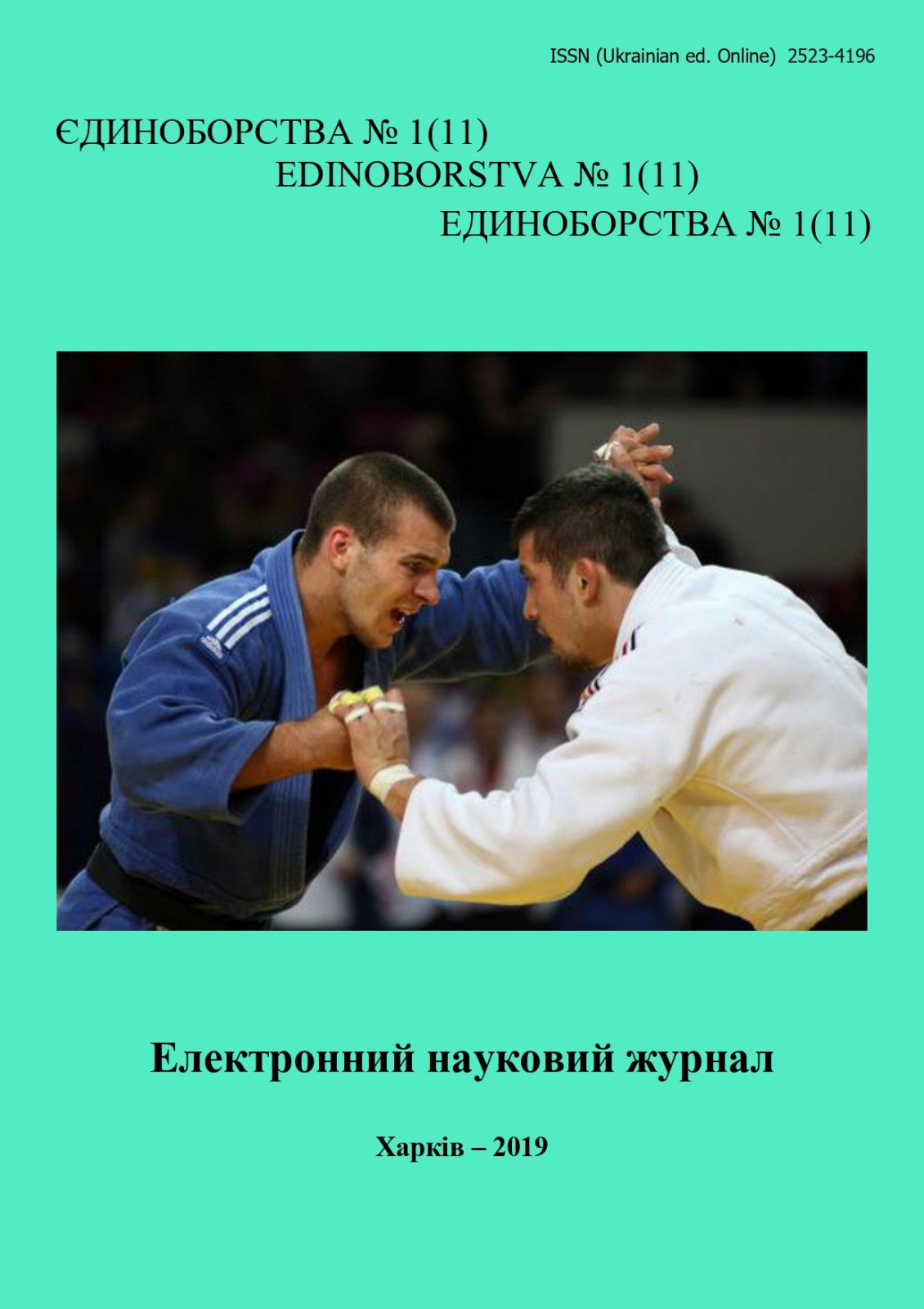The main directions of improving the competitive activities of the Sumoists
Keywords:
Sumoists, competitive activity, methods, development, throwAbstract
Purpose: to identify the main directions of improving the competitive activities of sumo wrestlers. Material and methods. The main criterion for evaluating the success of the training process is the successful performance in competitions. For the experimental and control groups, such competitions became the championship of IC Adrenalin, held at the end of the school year. Research methods: theoretical analysis and synthesis of scientific and methodological literature; pedagogical observation; expert video analysis; modeling of competitive activity; test method; pedagogical experiment; methods of mathematical statistics. Results. The model characteristics of a highly qualified athlete will be as follows: height - 181-185 cm; weight - 139-155 kg age at which the maximum result is achieved - 29 years; the ratio of height (cm) to weight (kg) - 1: (0.77-0.84) number of tournaments. As a result of the research, patterns of sumo duels were revealed, the key moments of the duel were determined. As a result of the introduction of specially developed exercises developed by us into the training process of the sumoists of the Kharkiv region (one year later), the number of winning and summary draws of the starting jerks increased from 20 to 80%. After analyzing the data obtained, we can conclude that in the experimental group there is a positive average connection between the technique of throwing, the technique of maneuvering and the result of performance in competitions 0,51, 0,54, respectively. The obtained coefficients show that in this experiment the success of the experimental group’s performances in the control competitions depended mainly on the ability to technically correctly perform relatively uncomplicated throws, punches and on the ability to quickly, timely, given the distance to the opponent to move. In turn, an analysis of the results of competitive activities of athletes from the EG to assess the tactical actions of sumo wrestlers in a fight suggests that they had an increase in starting jerks. The average tactical activity increased from 0,3 to 1,8. Conclusions: As a result of our research, complexes of spamming exercises for modeling basic technical and tactical actions in the most typical situations of competitive activity in sumo have been developed; revealed high efficiency of the proposed exercise complexes.
References
Алексєєв, А. Ф., Ананченко, К. В., & Бойченко, Н. В. (2014). Теорія та методика викладання дзюдо та самбо: навч. посіб. для студенів 3 курсу (за кредитно-модульною системою). ХДАФК, Xарків.
Ананченко, К. В., Бойченко, Н. В., & Панов, П. П. (2017). «Вдосконалення координаційних здібностей юних дзюдоїстів». Единоборства, 4-11.
Ананченко, К. В., & Хацаюк, О. В. (2018). «Особливості тренувального процесу та техніко-тактичної підготовленості дзюдоїстів-ветеранів». Единоборства, 4-18.
Арзютов, Г. Н., & Бородин, Ю. А. (2010). «Методология теории поэтапной многолетней подготовки спортсменов в единоборствах». Физическое воспитание студентов, 2, 7-10.
Бойченко, Н. В., Станкевич, Б., & Дрозд, М. С. (2014). «Контроль за станом підготовленості борця». Проблемы и перспективы развития спортивных игр и единоборств в высших учебных заведениях, 1, 14-17.
Буравцов, В. В. (2012). «Дослідження стійкості пози у боротьбі сумо». Физическое воспитание студентов, 23-27.
Ермаков, С. С., Тропин, Ю. Н., & Бойченко, Н. В. (2016). «Специальная физическая подготовка квалифицированных борцов». Единоборства, 20-22.
Коробко, С. В. (2004). «Моделирование технической подготовленности спортсменов в борьбе сумо». Физическое воспитание студентов творческих специальностей, № 2, 89-100.
Куванов, В. А., & Дорофеев, В. А. (2016). «Силовая подготовка борцов сумо». Современное образование: содержание, технологии, качество, 1, 299-302.
Ложечка, М. В. (2014). «Определение уровня физической подготовленности детей младшего школьного возраста, занимающихся сумо». Известия Тульского государственного университета. Физическая культура. Спорт, (2).
Платонов, В. Н. (2015). Система подготовки спортсменов в олимпийском спорте. Общая теория и ее практические приложения : учебник [для тренеров] : 2 кн. Олимп. лит., Киев.
Правдов, М. А., Челышев, Н. Н., Бубочкин, Б. П., & Баженов, Ю. И. (2013). «Физическая подготовка юных спортсменов, занимающихся борьбой на поясах».
Современные исследования социальных проблем (электронный научный журнал), 11-11.
Праотцев, С. В., Морачёва, Л. М., & Цвиров, А. Е. (2001). Основы сумо. Япония сегодня. Москва.
Романенко, В. А. (2005). Диагностика двигательных способностей. «Новый мир», УКЦентр, Донецк.
Тропин, Ю. Н., & Бойченко, Н. В. (2017). «Содержание различных сторон подготовки борцов». Единоборства, 79-83.
Цой, С. В., & Федоткин, А. Ю. (2009). «Оценка тактических действий сумоистов в схватке». Вестник спортивной науки, (1).
Ягелло, В., Ткачук, В. Г., & Блах, В. (2004). «Взаимосвязь антропометрических показателей с уровнем спортивного мастерства высококвалифицированных дзюдоистов Польши». Физическое воспитание студентов, (2), 36-45.













